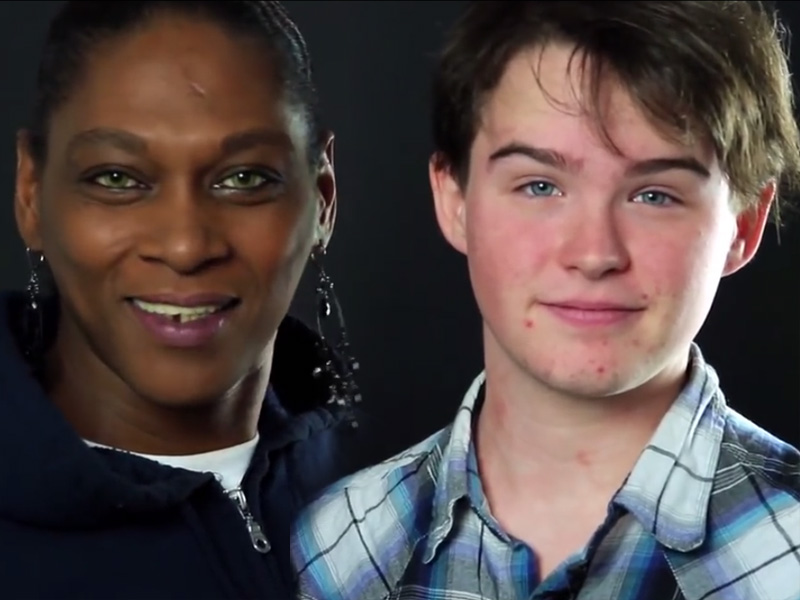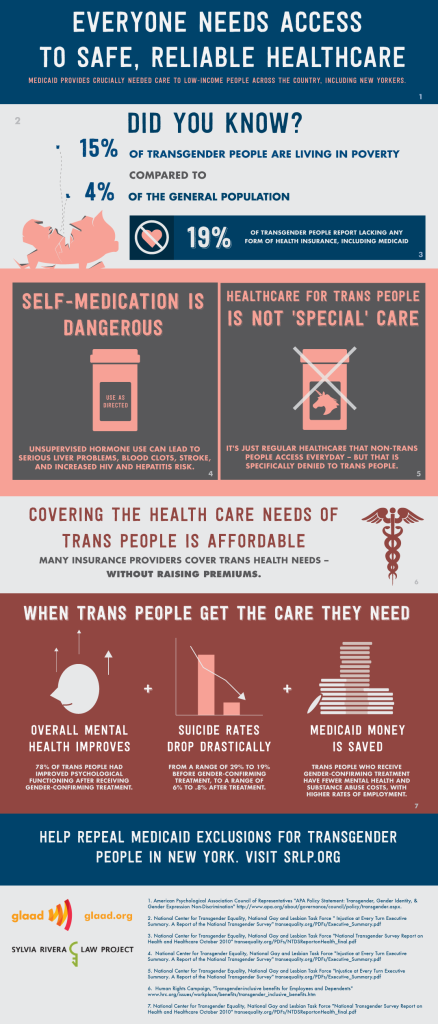
This Media Campaign Is As Awesome As Trans-Exclusionary Medicaid Regulations Are Terrible
The mainstream media does a piss poor job reporting about trans issues and people. Grantland proved that last week with the Dr. V tragedy. Katie Couric proved it last month when she asked Laverne Cox and Carmen Carrera about their genitals. Newspapers and TV stations around the country proved it thoroughly last year in their coverage of Chelsea Manning coming out as transgender.
With the advent of the internet and all its related whatnots, it’s gotten easier for queer and trans people to make our own media that represents our values, goals and selves. We prove that every day here on Autostraddle. If you’re in the Northeast, you might have seen this awesome video:
It’s part of a media and activism campaign by the Sylvia Rivera Law Project, GLAAD, and TransJustice, a program of the Audre Lorde Project. The groups are demanding that New York repeal a law prohibiting state Medicaid recipients from receiving coverage for care related to transition, including hormones, supplies and surgery.
I hope in a couple generations, kids look at us like we are insane when we tell them about the current state of health care in this country (“But gramma, what do you mean there were children who couldn’t go to the doctor when they got sick?” is a question I want to have to answer). For trans people, especially trans women of color, the picture is particularly dire, since so often their care is deliberately excluded from insurance plans. In 2010, 19 percent of trans people reported having no health insurance at all, compared to 15 percent of the general population. According to the Injustice at Every Turn report, almost half of trans people report delaying needed health care because they can’t pay. Trans people have higher rates of HIV infection, smoking, drug and alcohol use, and suicide attempts than the general population. Of respondents, 19 percent reported being refused medical care because they were trans; the rate was higher among trans people of color.
Only five states, most recently Connecticut, require health insurance providers to cover transition care even though the American Medical Association recommends “public and private health insurance coverage for treatment of gender identity disorder as recommended by the patient’s physician.” (Sidenote: GLAAD advises that the term “gender identity disorder” is “a controversial DSM-IV diagnosis” and “because it labels people as ‘disordered’… is considered offensive.”)
TransJustice is a community organization with a membership of primarily middle-aged and older trans women of color, most of whom are receiving some kind of public benefits, Elliott Fukui, the coordinator of TransJustice said. When the state passed the regulation banning state Medicaid from covering transition related services in 1998 after pressure from the public, it was a huge blow to the community. The Sylvia Rivera Law Project has been working to expand access to health care for trans people since it began in 2002. TransJustice and GLAAD teamed up with the organization for the campaign that launched in November.
Public opinion and public policy are currently shifting to be more inclusive of trans people, said Elana Redfield, a staff attorney at the Sylvia Rivera Law Project. So the time is ripe for this kind of action.
“The [Governor Andrew] Cuomo administration has put out a lot of messaging that it wants to improve Medicaid even as it streamlines it and makes it more efficient,” Redfield said. “Even though they have more or less recoiled from the hot potato of trans health care, we think its possible to hold them to their word.”
Failure to cover trans care has no economic basis — cities and states that cover transition-related medicine, surgery and supplies report no or marginal increases to state costs. According to the Human Rights Campaign, “When the City and County of San Francisco made its employee insurance plans transgender-inclusive in 2001, it set up an additional per-employee per-month surcharge to offset the expected additional expenditures. By 2006, it had only spent $386,417 of the $5.6 million it had collected from this surcharge. It ended the surcharge completely.”
In fact, lack of care can be more expensive because patients who can’t receive care for their treatment through safe channels may turn to buying hormones off the street or get surgeries from unlicensed practitioners and then develop serious medical problems, according to Fukui. It’s politics, not economics or medical concerns, that drive the refusal to cover health care for trans and gender nonconforming people, he said.
“New York draws a lot of LGBT people, and people think that if they get here they’ll have access to the things they need,” Fukui said. “We have a very large trans population here, and folks are coming here and realizing that the things that happen everywhere are happening here and it’s not quite a liberal gay utopia they were hoping for.”
That’s why media campaigns like the one by this coalition are so critical. Many people have no idea of how broad and devastating the effects of policies like the one in New York can be, nor do they know what “trans health care” entails.
“We want people to know that trans-inclusive healthcare isn’t “special” healthcare,” said Dani Heffernan, GLAAD’s media strategist. “It’s the same healthcare that people who aren’t trans have access to when they need it, but it’s specifically denied to trans people under many health insurance policies, including New York State Medicaid.”
For example, menopausal women can receive coverage for estrogen treatment through Medicaid, but trans women are not eligible for coverage for the exact same treatment.
The media campaign focuses on simple data and ideas, incorporates the stories of people with a stake in the issue, and is visually compelling. The talking points are easy to share and make sense as audio, video and print materials.

Via Sylvia Rivera Law Project
The campaign has also included direct activism, like a banner drop at a December rally where New York State Health Commissioner Nirav Shah spoke and a change.org petition. The New York Department of State Health Services did not return multiple requests for comment on the campaign or the rule.
Visibility for trans issues has boomed in the last three years, Fukui said, and media campaigns like this one are an important part of that change. But direct community action is still at the core of organizations like TransJustice, he added. The community drives the goals, and face to face interaction is necessary to stay grounded in the diverse and complex realities trans people experience.
“We recognize that as much as this is a gender thing, it’s also a racialized thing and a class thing. We also need to be mindful of how this will impact folks who are undocumented, folks who are in prisons and jails, folks who are in psych wards, and that those folks who are most marginalized are often the ones we don’t get to see,” Fukui said. Although this campaign is centered on New York, “We’re pushing for policy change, and we know these are issues across the board – there should be healthcare for everyone and we don’t have that in this country.”
Campaigns like this one make an impact on multiple levels. It elevates the voices of marginalized people, which empowers communities. It educates viewers on the topic at hand. And, it gives mainstream reporters tools to use when they report on the topic. Hopefully one day we won’t need YouTube videos that explain that trans people are human beings who need healthcare just like everyone else.